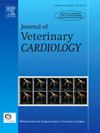犬创伤后室间隔血肿
IF 1.3
2区 农林科学
Q2 VETERINARY SCIENCES
引用次数: 0
摘要
一只6岁的绝育雄性Airedale梗犬,在被汽车撞击后颅脑损伤和休克,出现创伤后心律失常,在血液动力学和神经系统稳定后仍持续存在。心肌肌钙蛋白I明显升高。经胸超声心动图和计算机断层血管造影显示室间隔病变,符合心肌分裂和壁内血肿形成。在接下来的几周内,心脏病变几乎完全消退。初次就诊后一年左右,犬出现右侧充血性心力衰竭,室间隔薄且不均匀,心腔扩张,肺动脉扩张,伴肺动脉高压,可能继发于左心疾病。最终,由于对药物治疗反应不佳,这只狗在第一次失代偿后大约一年被安乐死。室间隔血肿在人类中是罕见的事件,通常与心脏手术、创伤或急性心肌缺血有关。这是第一个被描述为创伤后室间隔血肿的狗,已经通过超声心动图和横断面成像广泛记录。本文章由计算机程序翻译,如有差异,请以英文原文为准。
Post-traumatic interventricular septal hematoma in a dog
A six-year-old, neutered male, Airedale terrier with craniocerebral injury and shock after being hit by a car developed post-traumatic arrhythmia, which persisted after hemodynamic and neurological stabilization. Cardiac troponin I was markedly elevated. Transthoracic echocardiography and computed tomography angiography revealed an interventricular septal lesion, compatible with a myocardial splitting and intramural hematoma formation. The cardiac lesion resolved almost completely during the following weeks. About one year after initial presentation, the dog was referred with signs of right-sided congestive heart failure, thin and inhomogeneous interventricular septum, dilated cardiac chambers, and pulmonary artery, compatible with pulmonary hypertension, likely secondary to the left heart disease. Eventually the dog was euthanized due to poor response to medical therapy, approximately one year after his first decompensation. Interventricular septal hematomas are rare events in people, usually associated with cardiac surgery, trauma, or acute myocardial ischemia. This is the first dog described with a post-traumatic septal hematoma that has been extensively documented by means of echocardiography and cross-sectional imaging.
求助全文
通过发布文献求助,成功后即可免费获取论文全文。
去求助
来源期刊

Journal of Veterinary Cardiology
VETERINARY SCIENCES-
CiteScore
2.50
自引率
25.00%
发文量
66
审稿时长
154 days
期刊介绍:
The mission of the Journal of Veterinary Cardiology is to publish peer-reviewed reports of the highest quality that promote greater understanding of cardiovascular disease, and enhance the health and well being of animals and humans. The Journal of Veterinary Cardiology publishes original contributions involving research and clinical practice that include prospective and retrospective studies, clinical trials, epidemiology, observational studies, and advances in applied and basic research.
The Journal invites submission of original manuscripts. Specific content areas of interest include heart failure, arrhythmias, congenital heart disease, cardiovascular medicine, surgery, hypertension, health outcomes research, diagnostic imaging, interventional techniques, genetics, molecular cardiology, and cardiovascular pathology, pharmacology, and toxicology.
 求助内容:
求助内容: 应助结果提醒方式:
应助结果提醒方式:


